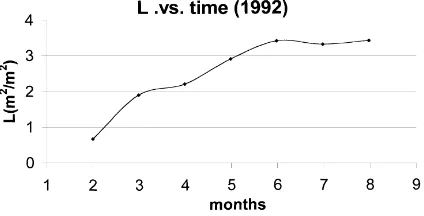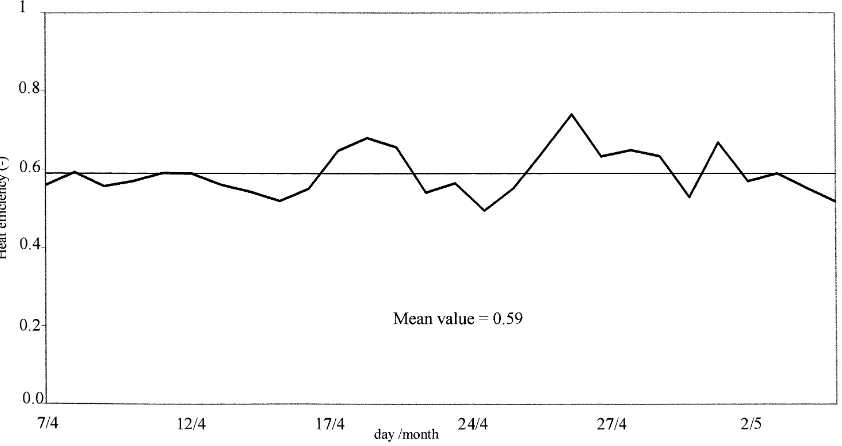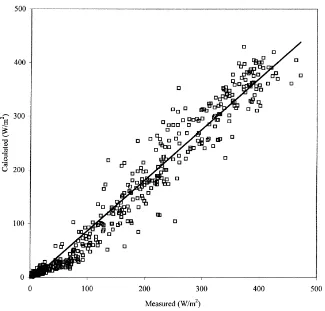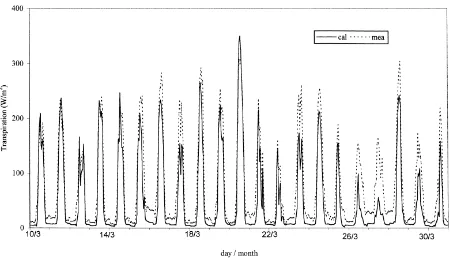Greenhouse crop transpiration simulation from external
climate conditions
T. Boulard
∗, S. Wang
I.N.R.A. - Station de Bioclimatologie - Site Agroparc, Domaine Saint Paul, 84914 Avignon Cedex 9, France
Received 23 April 1999; received in revised form 2 August 1999; accepted 5 August 1999
Abstract
A new and simple greenhouse crop transpiration model enabling predictions from outdoor conditions is presented and the parameters involved are discussed with respect to different types of greenhouse-crop systems. This transpiration model was validated against experimental data measured in a soil-less tomato crop cultivation in Avignon in summer conditions, when the greenhouse is open, and early spring climatic conditions, when the greenhouse is kept closed and the inside air strongly confined. The evapo-condensation phenomena on the greenhouse cover, particularly important when the greenhouse is closed, are not considered in the water vapour balance. Model estimation improved from spring to summer and comparisons with previous transpiration models have shown that considering outside climate instead of inside climate as a boundary condition implied a deterioration of transpiration model performances especially when greenhouse air is confined. This deterioration is primarily due to simplifications introduced during the model derivation and model performances were satisfactory when the greenhouse air was closely coupled to outdoor conditions. ©2000 Elsevier Science B.V. All rights reserved.
Keywords: Greenhouse; Transpiration; Greenhouse climate; Water balance; Ventilation
1. Introduction
Previous steps in the development of physically based models of greenhouse crop transpiration con-sidered the water vapour exchange between the pro-tected canopy and the inside air. Crop transpiration is expressed as the sum of a radiative component, pro-portional to the radiation absorbed by the crop, and an advective term, proportional to the inside air satu-ration deficit.
Transpiration models with the greenhouse climate as a boundary condition were first developed in the northern regions of Europe and North America for
∗Corresponding author. Tel.:+33-4-9031-6080;
fax:+33-4-9089-9810.
E-mail address: [email protected] (T. Boulard).
horticultural crops: tomato (Stanghellini, 1987; Jolliet and Bailey, 1992), cucumber (Yang et al., 1990), let-tuce (Pollet et al., 1999). In these northern conditions, the glasshouse is generally poorly ventilated during a large part of the growing season. The boundary layer conductance for glasshouse crops tends to be much smaller than would be expected for similar crops grow-ing outdoors. Thus, glasshouse crops are very strongly decoupled from the outside atmosphere by the pres-ence of the glass, and the heat and the water released at crop surface will accumulate inside the glasshouse. Consequently, the transpiration rate will adjust until it reaches a stable equilibrium transpiration rate dictated by the net radiation received (Jarvis, 1985).
On the contrary, greenhouse crop transpiration in Mediterranean or similar warm conditions is much more dependent on convection. As the ventilation and
the turbulent mixing are vigorous, the saturation deficit at the leaf surface is closely coupled to the deficit of ambient air, and the latter is directly influenced by the outdoor saturation deficit. The advective contri-bution represents 43% of the total transpiration for a May–June greenhouse tomato crop in the South of France (Jemaa, 1995) and both radiative and advec-tive components of transpiration must be considered in models (Boulard et al., 1991; Papadakis et al., 1994). From an operational point of view, the calculation of greenhouse crop transpiration from outside climate is interesting. This is the case in Mediterranean coun-tries where the advective term of transpiration can hardly be estimated because the greenhouses consist of simple shelters, such as tunnels or wooden struc-tures, seldom equipped with inside climate-sensors, which allow calculation of crop transpiration. In ad-dition, when the coupling between inside and outside climatic conditions increases, due to open windows, there are real needs for greenhouse crop transpiration models enabling simulations based on outdoor condi-tions.
In this paper, we shall derive the basic equations for greenhouse crop transpiration. The parameters in-volved will be discussed with respect to crop and greenhouse types and the model will be tested against measured data for a tomato crop in both winter and summer conditions.
2. Theory
2.1. Derivation of crop transpiration with respect to external climatic parameters
The greenhouse-crop system can be considered as a solar collector involving both sensible and latent heat exchanges and its thermal performances can be de-scribed in a similar way by the use of a single energy balance equation (Seginer and Albright, 1983; Okano et al., 1985; Boulard and Baille, 1993). The main pa-rameters involved are: the solar efficiency factor (π) and the overall energy loss coefficient per square me-tre of greenhouse soil surface (KS, W m−2K−1).
The greenhouse energy balance can be written
λE+H =π Rg+Qh−G−KS1T (1)
where E is the canopy transpiration (kg m−2s−1),λ
the latent heat of water vaporisation (J kg−1), H the
sensible heat exchange by ventilation (W m−2), Rg
the outside global solar radiation (W m−2), Qh the
heating flux density (W m−2) provided by the
heat-ing system, G the heat storage or retrieval rate of the greenhouse-soil system (W m−2), KS the overall heat
transfer coefficient between inside and outside and1T
the air temperature difference between inside and out-side (K).
The latent heat exchange due to canopy transpira-tion can be expressed with respect to the difference of air humidity between indoors and outdoors:
λE=Kv1e (2)
where1e is the water vapour pressure gap between
the interior and exterior air (Pa) and Kvis the latent
heat transfer coefficient (W m−2Pa−1).
The sensible heat exchange by ventilation can also be expressed with respect to the difference of air tem-perature between indoors and outdoors:
H=KH1T (3)
where1T is the temperature gap between interior and
exterior air (K) and KH the sensible heat transfer
co-efficient (W m−2K−1).
Greenhouse crop transpiration can be deduced from
the greenhouse available energy (λE+H) and from
the inside air saturation deficit Di (Pa), by means of
the Penman–Monteith formula:
λE= δ(λE+H )+2LρCpDi/ra
δ+γ (1+rs/ra)
(4)
where Cpandρare the specific heat of air at constant
pressure (J kg−1K−1) and the air density (kg m−3),γ
is the psychometric constant (Pa K−1), ra and rs are
the aerodynamic and stomatal resistances of the leaves (s m−1) and L is the leaf area index for the whole floor area including pathways.
The water vapour pressure deficit of the interior air (Di) can be expressed as a linear function of the water
vapour pressure deficit and temperature of exterior air,
Doand To:
Di=δ(To)(1T )−1e+Do (5)
whereδ(To) is the slope of the water vapour saturation
a linear system of five equations with five unknowns (λE, H, Di,1T and1e) which can be solved
analyti-cally. Consequently,λE can be expressed with respect
to the outside climate and greenhouse-crop parame-ters.
Combining Eqs. (1) and (3) yields
1T = 1
KH+KS
(π Rg+Qh−G−λE) (6)
By introducing Eq. (2), Eq. (5) becomes
Di=δ1T −
λE Kv
+Do (7)
Combining Eqs. (3) and (4) yields
λE=δ(λE+KH1T )+2LρCpDi/ra
δ+γ (1+rs/ra)
(8)
The above simplifications allow us to obtain a sim-plified system with three equations (Eqs. (6)–(8)) and
three unknowns (λE, Di and1T).
Eq. (8) can be simplified as follows:
λE=K1KH1T +K2Di
Combining Eqs. (7) and (9) eliminates Di:
λE=(K1KH+K2δ)1T +K2Do
1−K1+(K2/Kv)
(12)
1T is removed by combining Eqs. (6) and (12) and
the crop transpiration can finally be expressed with respect to external climatic parameters and transfer coefficients:
The solar heating efficiency of the greenhouse (π) is a key factor that strongly modulates the influence of
solar radiation (Seginer and Albright, 1983, Boulard and Baille, 1993). It can be deduced from the green-house energy balance (1) over 24-hour periods:
P
λE+P
H =πP
Rg+PQh−PG−KSP1T
Assuming that the sum of soil heat storage and re-trieval (P
G) is approximately null over a 24-hours
period, we get a simple formula enabling the identifi-cation ofπ:
The overall energy loss coefficient can be considered
as dependent on external wind speed V (m s−1)
fol-lowing the simple relation (Bailey and Cotton, 1980):
KS =A+BV (15)
where A and B depend on the greenhouse design (ratio of the soil surface, on the greenhouse cover: Ss/Sc),
on the type of the cover material (glass, polyethylene, PVC) and the presence of a single or double cover.
The coefficients for the transfer of sensible and la-tent heat by ventilation, KH and Kv, are proportional
to the ventilation flux, φv (m3s−1). Ignoring
buoy-ancy forces, the latter can be considered to be linearly dependent on the vent opening area and wind speed (Boulard and Baille, 1995; Kittas et al., 1995):
φv=
S0
2 CdC
0.5V (16)
where C is a wind related efficiency coefficient, Cd
is an average vent discharge coefficient and S0is the
vent opening area (m2).
conversion factor between the air water vapour content (kgwkga−1) at standard temperature and the air water
vapour pressure (Pa), 6.25×10−6kgwkga−1Pa−1.
δ = 2504000
(T −35.86)2e
17.27(T−273.16)/(T−35.86) (19)
According to Avissar et al. (1985), the stomatal resis-tance can be considered to be dependent on the inside level of global radiation and inside air temperature and humidity based on exponential laws. For greenhouse tomato crops, the effects of radiation on stomatal re-sistance is the most crucial and obeys the following relation (Boulard et al., 1991):
rs = 200
whereτ, is the transmittance of the greenhouse cover. The aerodynamic resistance, ra, mainly depends on
the aerodynamic regime that prevails in the green-house. If we consider that the buoyancy force can be ignored with respect to the wind force, ra can be
di-rectly expressed with respect to the average interior air speed:
ra=220
d0.2
Vi0.8 (21)
where d is the characteristic length of the leaf (m). Vi,
the mean interior air speed (m s−1), can be considered to be proportional to the ventilation fluxφvdivided by
Ac (m2), the vertical cross-section area perpendicular
to the average direction of the inside air flux, in this case the greenhouse axis (Wang et al., 1999):
Vi =
φv
Ac
(22)
3. Materials and methods
3.1. Greenhouse and experimental set up
The study was carried out from March to June in a climate controlled bi-span plastic-house equipped with both heating and cooling devices. The greenhouse was 32 m long in the north–south direction and consisted of two spans, each of 6.5 m width. The mean height was 4 m. Two vents, each 1.06 m wide, ran the length of the entire greenhouse near the gutters. The ratio of the total vent area to ground area was 0.32. Maximum vent opening angle of the vents was 58◦.
Tomato plants, c.v. Rondello, were planted in dou-ble rows (density=2 plants/m2) in January and grown
Fig. 1. Tomato crop Leaf Area Index (L) as a function of time. February to August 1992.
on rockwool slabs placed on a white plastic mulch. The heating and ventilation set points were approxi-mately 17 and 22◦C, respectively. The leaf area index (L) was estimated each month from measurements of leaf dimensions (Jemaa, 1995) and the daily data were interpolated (Fig. 1).
3.2. Climatic and transpiration measurements
Inside and outside climate variables, dry and wet bulb temperatures and global radiation were monitored at hourly time increments, together with the state of the actuators (vent opening) and the heating energy consumption.
Crop transpiration was determined by means of a weighing lysimeter (maximum load 120 kg,
pre-cision±10 g) supporting four plants. All the
mea-surements were sensed every minute, averaged on the hourly basis and stored in a data logger. A com-plete description of the greenhouse and climatic and transpiration measurements can be found in Draoui (1994) and Jemaa (1995).
4. Results and discussion
All the forthcoming results were determined using data collected during two successive years: 1991 and
1992. The solar efficiency of the greenhouse,π, was
conditions, were also used for the identification of the parameters of the ventilation model (Boulard, 1993).
4.1. Solar efficiency,p
The daily course of the identified value of π (Eq.
(14), with KS=6+0.5 V) from 7 April to 4 May is
given in Fig. 2. It averagedπ=0.59, to be compared
withπ=0.50, found in a 7 m tunnel occupied by a
young tomato crop (Sbita et al., 1998), orπ=0.56 for a single glazed greenhouse (Garzoli, 1985). The stan-dard mean deviation is equal to 0.05. These variations can be due to simplifications in the heat and mass and ventilation models which will be analysed in Section 4.4, or to errors in the measurement of the involved climatic parameters T, Rg, e and V.
4.2. Crop transpiration
Assuming that G was negligible with respect to the other terms of the heat balance and using the iden-tified value of solar efficiency (π=0.59), the tran-spiration model was validated with respect to two types of climatic conditions: (i) summer or late spring climatic conditions, when the coupling between the
Fig. 2. The greenhouse solar efficiency (π) as a function of time. 7 April to 4 May 1991.
greenhouse crop and the outside climate was impor-tant and (ii) winter or early spring climatic conditions, when the greenhouse was not ventilated and the inside air strongly confined.
Calculated versus measured greenhouse crop tran-spiration fluxes together with their regression lines and statistical parameters are given on an hourly basis in Figs. 3 and 4 for the periods 1–31 May 1992, and 10–31 March 1992, respectively. Model estimation im-proved from March to May, as seen by the increase of the slope of the regression line and by the improve-ment of the correlation coefficient. The standard de-viations are similar in March and in May (23 W m−2) and the slopes of the regression lines are always lower than 1, especially in March, which indicates that the model systematically underestimates the transpiration fluxes.
Fig. 3. Calculated (λEcal, present transpiration model) versus measured (λEmes, lysimeter measurement) values of greenhouse crop
transpiration rate.λEcal=0.95λEmes+7.64, regression coefficient: R2=0.97, standard deviation:σ=23.29 W m−2, N=744 values, 1–31
May 1992, hourly basis. The precision of the lysimeter measurement was about±3.5 W m−2.
Larger discrepancies are noticed in March during night-time when the greenhouse was closed and when the heating system was systematically activated. A similar deterioration of model performances can also be observed in daytime when the transpiration flux was weak, as was the case during cloudy days (corre-sponding to the days with low transpiration fluxes).
4.3. Comparison with previous models
Using the same experimental data and the same crop
parameters (L, rs), this model can also be compared
at an hourly time-step with previous greenhouse crop transpiration models based on the Penman–Monteith formula and considering only inside climate (Jemaa, 1995). The regression lines between measured and cal-culated transpiration fluxes and the associated
statis-tical parameters for the May and March periods are shown in Table 1.
It is clear that considering outside climate instead of inside climate as a boundary condition implies a dete-rioration of transpiration model performances. How-ever, in May we observed only a slight underestimation and loss of prediction of the model, while in March the underestimation of the transpiration fluxes reached
almost 20% and the R2decreased by 0.1 with respect
to the March value.
4.4. Model limits
Fig. 4. Calculated (λEcal, present transpiration model) versus measured (λEmes, lysimeter measurement) values of greenhouse crop
transpiration rate.λEcal=0.85λEmes+14.27, regression coefficient: R2=0.89, standard deviation:σ=23.39 W m−2, N=504 values. 10–31
March 1992, hourly basis. The precision of the lysimeter measurement was about±3.5 W m−2. The evapo-condensation phenomena on the
house cover, particularly important when the green-house is closed, are not considered in the water vapour balance described by relation (2). Relation (5) allowing for the derivation of the water vapour pressure deficit of inside air (Di) as a linear function
of the water vapour pressure deficit and temperature of the exterior air, Do and To, is verified only when
es(Ti)−es(To)∼=δ(To)1T, i.e. when Ti is not too far
from To. This is not the case during winter when, as in
our experimental conditions, the greenhouse is heated. These two reasons could explain the majority of the discrepancies, however, other causes, due to the ventilation model, must also be examined.
Linearisation of the model requires a linear relation-ship describing ventilation. That is why relation (16)
neglects the buoyancy forces linked to 1T, though
these forces can be significant, particularly when1T
is high (1T > 5◦C) and V is low (V<1.5 m s−1). No leakage model was considered in our description of the air exchange rate and this can also explain a large part of the differences observed between simulations and measurements at night-time.
All these errors occur when the greenhouse is closed, but their magnitude is not significant because the transpiration fluxes are generally weak at that time. They could also be corrected but this would de-tract from the simplicity and robustness of the model.
4.5. Model applications
Fig. 5. Time courses of measured (lysimeter measurement) and calculated (present transpiration model) values of tomato crop transpiration rates. May 1992, hourly basis.
Table 1
Comparison of the regression lines and associated statistical parameters between the measured greenhouse crop transpiration (λEmeas) and
simulations performed by the present model (λEcal,o) and a previous model (λEcal,i) with inside climate as boundary conditions (Jemaa,
1995),σ: standard deviation of the regression line, R: regression coefficient
Transpiration models 1–31 May 1992; N: 744 points 10–31 March 1992; N: 504 points
PM and inside climate λEcal,i=1.01λEmeas+4.45,σ=13 W m−2, R2=0.99 λEcal,i=1.03λEmeas+4.4,σ=9.2 W m−2, R2=0.99
PM and outside climate λEcal,o=0.95λEmeas−7.46,σ=23 W m−2, R2=0.97 λEcal,o=0.85λEmeas−14.27,σ=23.4 W m−2, R2=0.89
transpiration which has already been thoroughly ex-amined, (ii) the calculations of the greenhouse heat and water vapour balances and (iii) the associated green-house inside air temperature and humidity. This latter takes into account relations (2) and (13) which enable deriving inside air humidity ei and relations (1), (3)
and (13) which compute inside air temperature Ti. The
limits of this approach are the same than the limits of the crop transpiration model. However, in order to implement this specific application, the modelling of the heat balance and particularly the description of the overall solar absorption and the system inertia have to be substantially improved.
This model could then be combined with models of cropping system behaviour (De Tourdonnet, 1998; Seginer et al., 1998) in order, for example, to explore different ways of managing fertilisation and irriga-tion with respect to outside climate and the control of greenhouse vent opening.
5. Conclusions
A new greenhouse crop transpiration model en-abling predictions from outdoor conditions is derived and the parameters involved are discussed with respect to the different types of greenhouse-crop systems.
Testing of the model in warm and cold conditions shows that estimations of the simulations improve from March to May and from nocturnal to diurnal periods.
The deterioration of model performances detected in winter and early spring is mainly due to simplifica-tions introduced during model derivation; nevertheless such deterioration mainly occur when the greenhouse is closed and generally when the transpiration fluxes are weak.
Finally it appears that the errors observed when the greenhouse is closed could be corrected, but that such
modifications would detract from the model’s simplic-ity and robustness. It is also shown that this transpira-tion model is designed to be used with simple shelters when inside conditions are closely coupled to outside ones, as is the case in Mediterranean conditions dur-ing most of the year.
In addition to the direct estimation of crop transpi-ration, this model could also be considered to deter-mine inside air temperature and humidity. It could be combined with models of cropping system behaviour using outside climate as boundary conditions.
References
Avissar, R., Avissar, P., Mahrer, Y., Bravdo, B.A., 1985. A model to simulate response of plant stomata to environmental conditions. Agric. For. Meteorol. 34, 21–29.
Bailey, B., Cotton., 1980. Glasshouse thermal screen: influence of single and double screens on heat loss and crop environment. NJAE Dept Note DN/G/821, 15 pp.
Boulard, T., Baille, A., Mermier, M., Vilette, F., 1991. Mesures et modélisation de la résistance stomatique foliaire et de la transpiration d’un couvert de tomate de serre. Agronomie 11, 259–274.
Boulard, T. 1993. Etude expérimentale et modélisation de l’aération naturelle des serres. Récapitulatif des résultats des études conduites de 1988 à 1992. Note interne I.N.R.A. 93-1 Station de Bioclimatologie de Montfavet.
Boulard, T., Baille, A., 1995. Modelling of air exchange rate in a greenhouse equipped with continuous roof vents. J. Agric. Eng. Res. 61, 37–48.
Boulard, T., Baille, A., 1993. A simple greenhouse climate control model incorporating effects of aeration and evaporative cooling. Agric. For. Meteorol. 65, 145–157.
De Tourdonnet, 1998. Maitrise de la qualité et de la pollution nitrique en production de laitues sous abri plastique. Thése de l’INA Paris-Grignon.
Draoui, B., 1994. Caractérisation et analyse du comportement thermohydrique d’une serre horticole. Thèse de l’Université de Nice Sophia-Antipolis, 120 pp.
Jarvis, P.G., 1985. Coupling of transpiration to the atmosphere in horticultural crops: thefactor. Acta Horticulturae 171, 187– 205.
Jemaa, R., 1995. Mise au point et validation de modèles de transpiration de cultures de tomate hors sol sous serre. Application à la conduite de la fert-irrigation. Thèse de l’ENSA Rennes, 111 pp.
Jolliet, O., Bailey, B.J., 1992. The effects of climate on tomato transpiration in greenhouses: measurements and models comparison. Agric. For. Meteorol. 58, 43–62.
Kittas, C., Draoui, B., Boulard, T., 1995. Quantification du taux d’aeration d’une serre a ouvrant continu en toiture. Agric. For. Meteorol. 77, 95–111.
Murray, F.W., 1967. On the computation of saturation vapour pressure. J. Appl. Meterol. 6, 203–204.
Okano, J., Albright, L.D., Pan, J.Q., Marsh, L.S., 1985. Greenhouse parameter estimation by recursive least square. Acta Hortic. 174, 433–441.
Papadakis, G., Frangoudakis, A., Kiritsis, S., 1994. Experimental investigation and modelling of heat and mass transfer between a tomato crop and the greenhouse environment. J. Agric. Eng. Res. 57, 217–227.
Pollet, S., Bleyaert, P., Lemeur, R., 1999. Calculating the evapotranspiration of head lettuce by means of the Penman–Monteith Model. In: 3rd International Workshop:
Models for Plant Growth and Control of the Shoot and Root Environments in Greenhouses. The Volcani Center, Bet Dagan, Israel, 21–25 February.
Sbita, L., Boulard, T., Baille, A., Annabi, M., 1998. A greenhouse climate model including the effects of ventilation and crop transpiration: validation for the south Tunisia conditions. ISHS 458, 57–64.
Seginer, I, Buwalda, F., van Straten, G., 1998. Nitrate concentration in greenhouse lettuces; a modelling study. Acta Hortic. 456, in press.
Seginer, I., Albright, D.,1983. Greenhouse operation for best aerial environment. Final research Report, BARD project I 117-79 Technion, Ha¨ıfa, Israël.
Stanghellini, C., 1987. Transpiration of greenhouse crops: an aid to climate management. Ph. D. Dissertation, Agricultural University, Wageningen, 150 pp.
Wang, S., Boulard, T., Haxaire, R., 1999. Measurements and analysis of air speed distribution in a naturally ventilated greenhouse. International Conference & British-Israeli Workshop on the Greenhouse Techniques towards the 3rd Millenium. 5–8 September 1999, Haifa, Israel.





